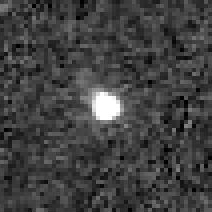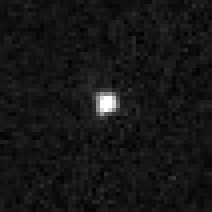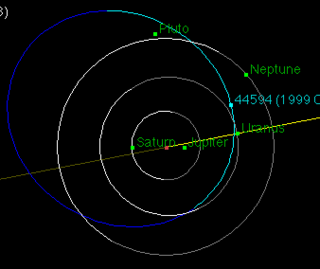Related Research Articles
(65407) 2002 RP120, provisional designation 2002 RP120, is a trans-Neptunian object and damocloid from the outer Solar System. Its orbit is retrograde and comet-like, and has a high eccentricity. It was discovered on 4 September 2002 by astronomers with the LONEOS survey at Anderson Mesa Station, Arizona, in the United States. The unusual object measures approximately 14.6 kilometers (9.1 miles) in diameter and is likely elongated in shape. It is a slow rotator and potentially a tumbler as well. The object was probably ejected from the ecliptic by Neptune.
(35671) 1998 SN165, prov. designation: 1998 SN165, is a trans-Neptunian object from the Kuiper belt located in the outermost region of the Solar System. It was discovered on 23 September 1998, by American astronomer Arianna Gleason at the Kitt Peak National Observatory near Tucson, Arizona. The cold classical Kuiper belt object is a dwarf planet candidate, as it measures approximately 400 kilometers (250 miles) in diameter. It has a grey-blue color (BB) and a rotation period of 8.8 hours. As of 2021, it has not been named.

(40314) 1999 KR16 is a trans-Neptunian object on an eccentric orbit in the outermost region of the Solar System, approximately 254 kilometers (158 miles) in diameter. It was discovered on 16 May 1999, by French astronomer Audrey Delsanti and Oliver Hainaut at ESO's La Silla Observatory in northern Chile. The very reddish object is a dwarf planet candidate and has a rotation period of 11.7 hours.

31824 Elatus (, provisional designation: 1999 UG5) is a very red centaur from the outer Solar System, approximately 48 kilometers (30 miles) in diameter. It was discovered on 29 October 1999, by astronomers of the Catalina Sky Survey at Mount Lemmon Observatory in Arizona, United States. The minor planet was named after Elatus, a centaur from Greek mythology.

32532 Thereus, provisional designation: 2001 PT13, is a centaur from the outer Solar System, approximately 80 kilometers (50 miles) in diameter. It was discovered on 9 August 2001, by astronomers of the Near-Earth Asteroid Tracking program at the Palomar Observatory in California, United States. This minor planet was named for the phrase thēreios bia 'beastly strength', used to describe centaurs in Greek mythology.

(44594) 1999 OX3 is an eccentric trans-Neptunian object with a centaur-like orbit from the outer Solar System, approximately 150 kilometers in diameter. It was discovered on 21 July 1999, by astronomers John Kavelaars, Brett Gladman, Matthew Holman and Jean-Marc Petit at Mauna Kea Observatories, Hawaii, United States.
(469306) 1999 CD158, provisional designation: 1999 CD158, is a trans-Neptunian object from the circumstellar disc of the Kuiper belt, located in the outermost region of the Solar System. The relatively bright hot classical Kuiper belt object measures approximately 310 kilometers (190 miles) in diameter. It was discovered on 10 February 1999, by American astronomers Jane Luu, David Jewitt and Chad Trujillo at Mauna Kea Observatories on the Big Island of Hawaii, United States.
(589683) 2010 RF43, provisionally designated: 2010 RF43, is a large trans-Neptunian object orbiting in the scattered disc in the outermost regions of the Solar System. The object was discovered on 9 September 2010, by American astronomers David Rabinowitz, Megan Schwamb and Suzanne Tourtellotte at ESO's La Silla Observatory in northern Chile.
(445473) 2010 VZ98, provisional designation 2010 VZ98, is a trans-Neptunian object of the scattered disc, orbiting the Sun in the outermost region of the Solar System. It has a diameter of approximately 400 kilometers.
2010 TJ is a trans-Neptunian object from the scattered disc in the outermost region of the Solar System and measures approximately 460 kilometers in diameter. It was first observed by American astronomers David Rabinowitz, Megan Schwamb, and Suzanne Tourtellotte at ESO's La Silla Observatory in northern Chile on 2 October 2010.
(310071) 2010 KR59, provisional designation 2010 KR59, is a trans-Neptunian object, approximately 110 kilometers in diameter. The object is trapped in a 1:1 mean motion resonance with Neptune, and rotates nearly every 9 hours around its axis. It was discovered on May 18, 2010 at 7:45 UT by the WISE spacecraft. The WISE telescope scanned the entire sky in infrared light from January 2010 to February 2011.
(523645) 2010 VK201, provisional designation 2010 VK201, is a trans-Neptunian object and member of the classical Kuiper belt, approximately 500 kilometers (310 miles) in diameter. It was discovered on 1 November 2010, by the Pan-STARRS 1 survey at Haleakala Observatory, Hawaii, United States. It has a rotation period of 7.6 hours. It was numbered in September 2018 and remains unnamed.

(82158) 2001 FP185, provisional designation 2001 FP185, is a highly eccentric trans-Neptunian object from the scattered disc in the outermost part of the Solar System, approximately 330 kilometers in diameter. It was discovered on 26 March 2001, by American astronomer Marc Buie at Kitt Peak National Observatory in Arizona, United States.
(336756) 2010 NV1, prov. designation: 2010 NV1, is a highly eccentric planet crossing trans-Neptunian object, also classified as centaur and damocloid, approximately 52 kilometers (32 miles) in diameter. It is on a retrograde cometary orbit. It has a barycentric semi-major axis (average distance from the Sun) of approximately 286 AU.

(127546) 2002 XU93, provisional designation 2002 XU93, is a trans-Neptunian object and centaur on highly inclined and eccentric orbit in the outer region of the Solar System. It measures approximately 170 kilometers (110 mi) in diameter and is one of few objects with such an unusual orbit. It was discovered on 4 December 2002, by American astronomer Marc Buie at the Kitt Peak National Observatory in Arizona, United States.
12929 Periboea, provisional designation: 1999 TZ1, is a dark Jupiter trojan from the Trojan camp, approximately 54 kilometers (34 miles) in diameter. It was discovered on 2 October 1999, by American astronomer Charles W. Juels at the Fountain Hills Observatory in Arizona. Originally considered a centaur, this now re-classified Jovian asteroid has a rotation period of 9.3 hours and belongs to the 80 largest Jupiter trojans. It was named from Greek mythology after Periboea, mother of Pelagon by the river-god Axius.
(342842) 2008 YB3, provisional designation: 2008 YB3, is a sizable centaur and retrograde damocloid from the outer Solar System, approximately 67 kilometers (42 miles) in diameter. It was discovered on 18 December 2008, by astronomers with the Siding Spring Survey at the Siding Spring Observatory in Australia. The minor planet was numbered in 2012 and has since not been named.
2011 MM4, provisional designation: 2011 MM4, is a sizable centaur and retrograde damocloid from the outer Solar System, approximately 64 kilometers (40 miles) in diameter. It was discovered on 24 June 2011, by astronomers with the Pan-STARRS 1 at the Haleakala Obs. in Hawaii.
(523702) 2014 HW199, provisional designation 2014 HW199, is a trans-Neptunian object from the classical Kuiper belt, located in the outermost region of the Solar System. It was discovered on 30 January 2011, by astronomers with the Pan-STARRS survey at Haleakala Observatory, Hawaii, United States. The classical Kuiper belt object is also a dwarf planet candidate, as it measures approximately 290 kilometers (180 miles) in diameter.
(523676) 2013 UL10 (prov. designation:2013 UL10) is a reddish centaur with cometary activity orbiting the Sun between Jupiter and Uranus. It was discovered on 18 August 2010, by a team of astronomers with the Pan-STARRS survey at the Haleakalā Observatory, Hawaii. It is the first centaur known to have both comet-like activity and red surface colors. It is also one of the smallest centaurs, with a nucleus of no more than 10 kilometers (6.2 miles) in diameter. As of 2021, it has not been named.
References
- 1 2 3 4 5 6 "JPL Small-Body Database Browser: (2010 WG9)" (2016-03-13 last obs.). Jet Propulsion Laboratory . Retrieved 25 July 2017.
- 1 2 "2010 WG9". Minor Planet Center. Retrieved 25 July 2017.
- 1 2 3 4 "LCDB Data for (2010)". Asteroid Lightcurve Database (LCDB). Retrieved 25 July 2017.
- 1 2 3 Bauer, James M.; Grav, Tommy; Blauvelt, Erin; Mainzer, A. K.; Masiero, Joseph R.; Stevenson, Rachel; et al. (August 2013). "Centaurs and Scattered Disk Objects in the Thermal Infrared: Analysis of WISE/NEOWISE Observations". The Astrophysical Journal. 773 (1): 11. arXiv: 1306.1862 . Bibcode:2013ApJ...773...22B. doi:10.1088/0004-637X/773/1/22. S2CID 51139703.
- 1 2 3 4 Rabinowitz, David; Schwamb, Megan E.; Hadjiyska, Elena; Tourtellotte, Suzanne; Rojo, Patricio (July 2013). "The Peculiar Photometric Properties of 2010 WG9: A Slowly Rotating Trans-Neptunian Object from the Oort Cloud". The Astronomical Journal. 146 (1): 10. arXiv: 1305.5134 . Bibcode:2013AJ....146...17R. doi:10.1088/0004-6256/146/1/17. S2CID 119206739.
- ↑ "List of Known Trans-Neptunian Objects". Johnston's Archive. Retrieved 26 July 2017.
- ↑ "Custom query: i = 60 and q = 15+". Minor Planet Center. Retrieved 26 July 2017.


